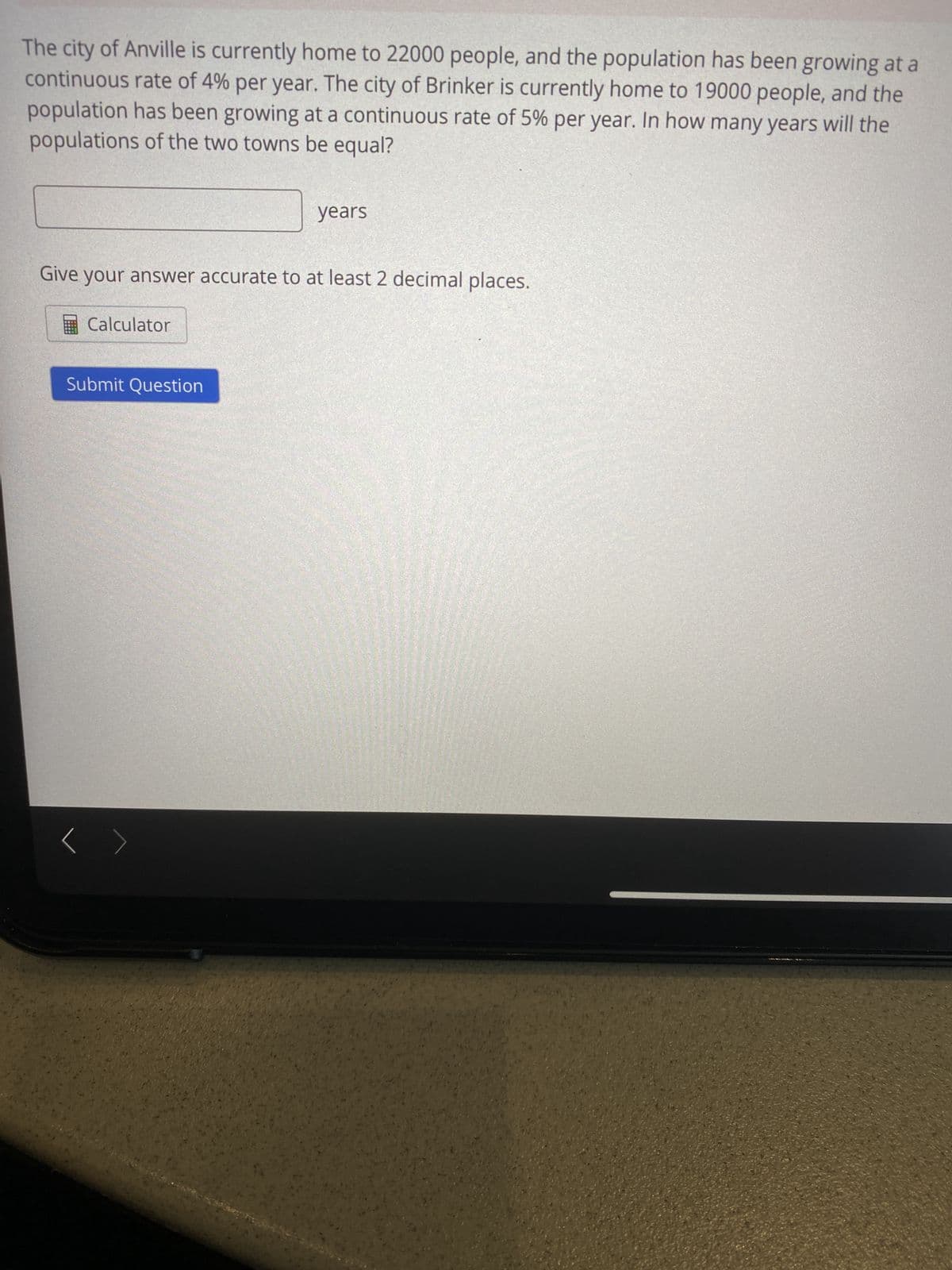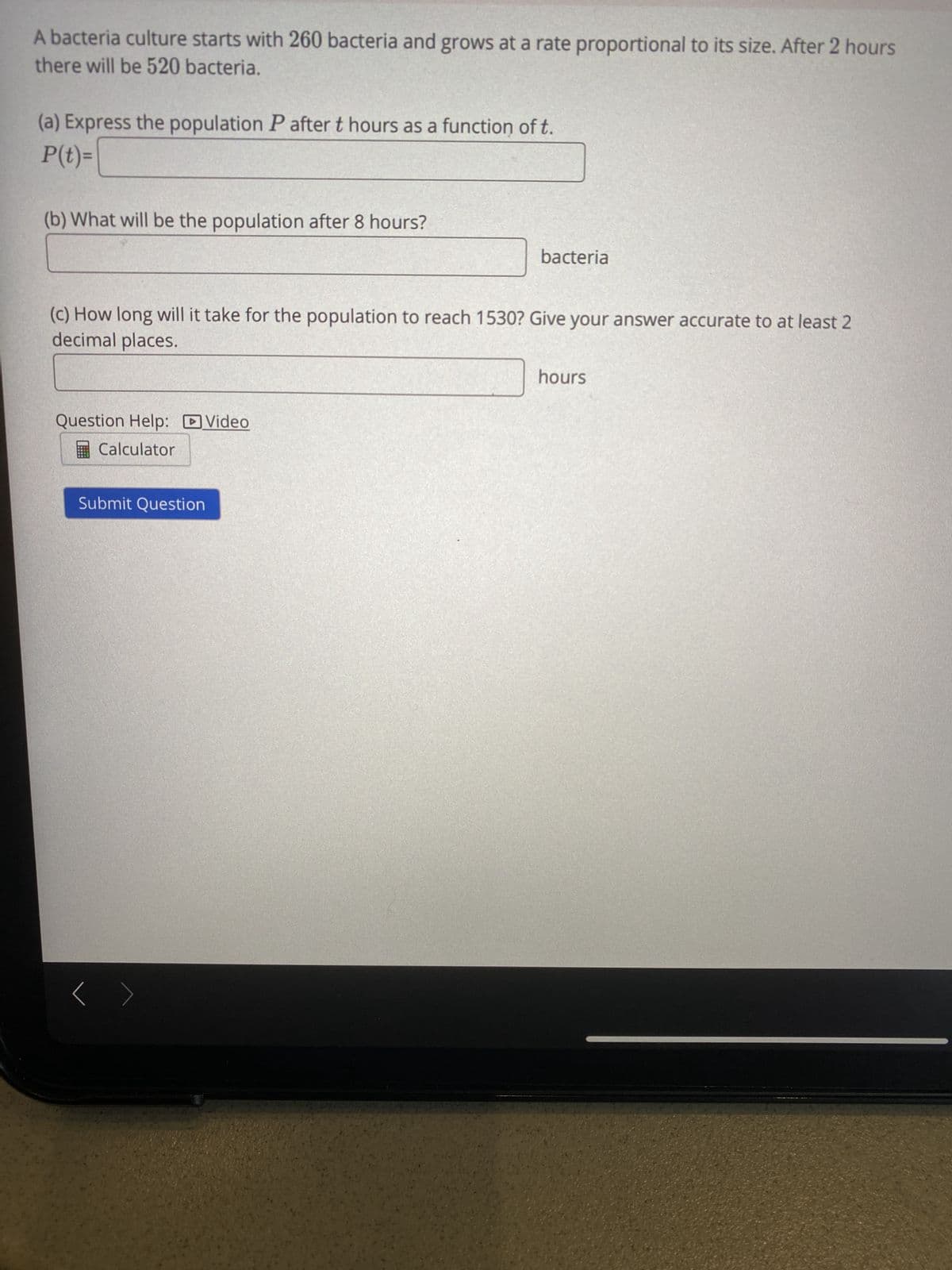The city of Anville is currently home to 22000 people, and the population has been growing at a continuous rate of 4% per year. The city of Brinker is currently home to 19000 people, and the population has been growing at a continuous rate of 5% per year. In how many years will the populations of the two towns be equal? years Give your answer accurate to at least 2 decimal places. E Calculator Submit Question A bacteria culture starts with 260 bacteria and grows at a rate proportional to its size. After 2 hours there will be 520 bacteria. (a) Express the population P after t hours as a function of t. P(t)= (b) What will be the population after 8 hours? bacteria (c) How long will it take for the population to reach 1530? Give your answer accurate to at least 2 decimal places. hours Question Help: DVideo Calculator Submit Question
The city of Anville is currently home to 22000 people, and the population has been growing at a continuous rate of 4% per year. The city of Brinker is currently home to 19000 people, and the population has been growing at a continuous rate of 5% per year. In how many years will the populations of the two towns be equal? years Give your answer accurate to at least 2 decimal places. E Calculator Submit Question A bacteria culture starts with 260 bacteria and grows at a rate proportional to its size. After 2 hours there will be 520 bacteria. (a) Express the population P after t hours as a function of t. P(t)= (b) What will be the population after 8 hours? bacteria (c) How long will it take for the population to reach 1530? Give your answer accurate to at least 2 decimal places. hours Question Help: DVideo Calculator Submit Question
Linear Algebra: A Modern Introduction
4th Edition
ISBN:9781285463247
Author:David Poole
Publisher:David Poole
Chapter6: Vector Spaces
Section6.7: Applications
Problem 13EQ
Related questions
Question

Transcribed Image Text:The city of Anville is currently home to 22000 people, and the population has been growing at a
continuous rate of 4% per year. The city of Brinker is currently home to 19000 people, and the
population has been growing at a continuous rate of 5% per year. In how many years will the
populations of the two towns be equal?
years
Give your answer accurate to at least 2 decimal places.
E Calculator
Submit Question

Transcribed Image Text:A bacteria culture starts with 260 bacteria and grows at a rate proportional to its size. After 2 hours
there will be 520 bacteria.
(a) Express the population P after t hours as a function of t.
P(t)=
(b) What will be the population after 8 hours?
bacteria
(c) How long will it take for the population to reach 1530? Give your answer accurate to at least 2
decimal places.
hours
Question Help: DVideo
Calculator
Submit Question
Expert Solution
This question has been solved!
Explore an expertly crafted, step-by-step solution for a thorough understanding of key concepts.
This is a popular solution!
Trending now
This is a popular solution!
Step by step
Solved in 2 steps

Recommended textbooks for you

Linear Algebra: A Modern Introduction
Algebra
ISBN:
9781285463247
Author:
David Poole
Publisher:
Cengage Learning

Glencoe Algebra 1, Student Edition, 9780079039897…
Algebra
ISBN:
9780079039897
Author:
Carter
Publisher:
McGraw Hill


Linear Algebra: A Modern Introduction
Algebra
ISBN:
9781285463247
Author:
David Poole
Publisher:
Cengage Learning

Glencoe Algebra 1, Student Edition, 9780079039897…
Algebra
ISBN:
9780079039897
Author:
Carter
Publisher:
McGraw Hill



Algebra & Trigonometry with Analytic Geometry
Algebra
ISBN:
9781133382119
Author:
Swokowski
Publisher:
Cengage

Functions and Change: A Modeling Approach to Coll…
Algebra
ISBN:
9781337111348
Author:
Bruce Crauder, Benny Evans, Alan Noell
Publisher:
Cengage Learning